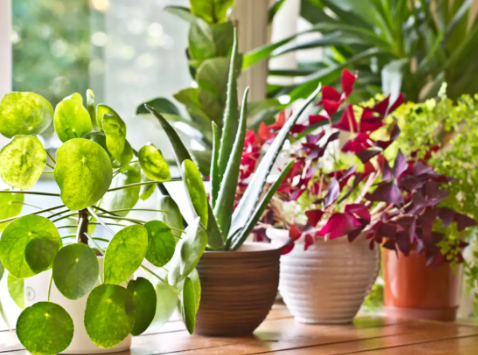Spathiphyllum (Peace Lily)
Regularly alluded to as a Peace Lily, this wonderful evergreen plant is broadly respected to be anything but difficult to think about, in any event, for those that don't have a green thumb. They require next to no light or water to stay sound, which is one of the fundamental reasons why they're one of the most mainstream plants to keep in your home.
 Chrysanthemum morifolium (Florist's Chrysanthemum)
Chrysanthemum morifolium (Florist's Chrysanthemum) Now and again called Florist's daisy or Hardy Garden Mum, this houseplant is another mainstream enduring plant that individuals like to have in their home. In contrast to the Peace Lily, this houseplant cherishes direct daylight and a medium measure of water.
Epipremnum aureum (Devil's Ivy)
Frequently called Devil's Ivy or Golden Pothos, this famous houseplant is local to the Soloman Islands, yet is can be discovered developing everywhere throughout the world.
Dracaena reflexa (Red-Edged Dracaena)
Frequently called Red-Edged Dracaena or Pleomele, Dracaena reflexa is an upstanding evergreen bush that produces slender green, yellow or cream-shaded leaves. When the plant begins to develop, you may see little white blossoms begin to sprout, in the blink of an eye followed by little red-orange berries.
Sansevieria trifasciata (Snake Plant)
Frequently alluded to as Snake Plant or Mother-In-Law's Tongue, this evergreen enduring plant is another houseplant that is known to improve your indoor air quality.
Rhapis excelsa (Lady Palm)
Most generally called the Lady Palm or Broadleaf Lady Palm, Rhapis excelsa is another houseplant that would be helpful to have around your home.
Anthurium andraeanum (Flamingo Lily)
Most generally called a Flamingo Lily or Laceleaf, Anthurium andraeanum is a delightful evergreen plant that is generally known for its beautiful blossoms. As per the NASA Clean Air Study, the Flamingo Lily was amazingly powerful at expelling airborne formaldehyde, alkali, toluene and xylene in your home or office.
Hedera helix (English Ivy)
Frequently called English Ivy or European Ivy, Hedera helix is another mainstream houseplant that helps channel airborne poisons inside your home. As per NASA's Clean Air Study, English Ivy is successful at purifying benzene, formaldehyde, xylene and toluene from the air. Moreover, different investigations have shown that English Ivy additionally decreases form in your home.
Gerbera jamesonii (Barberton Daisy)
Most usually known as a Barberton Daisy, Gerbera jamesonii is a delightful blooming plant that is local to Eastern Africa. While it is planned and for the most part utilized for open air use, it is getting increasingly mainstream to place them in holders for indoor use.
Ficus benjamina (Weeping Fig)
Most normally known as a Weeping Fig or Ficus tree, Ficus benjamina is famous houseplant that is additionally exceptionally powerful at cleansing the air in your home. As indicated by NASA's Clean Air Study, Ficus benjamina was compelling at purifying airborne formaldehyde, xylene and toluene.
The most effective method to Improve Your Indoor Air Quality
Each and every one of the houseplants recorded above are extraordinary apparatuses to improving your indoor air quality. Generally, they're anything but difficult to think about, ideal to have around and will assist you with breathing simpler around evening time. In any case, they're simply apparatuses to assist you with remaining sound. Over the long haul, there are numerous different things you can do to improve the air quality in your home.
